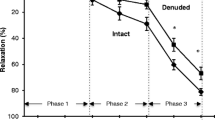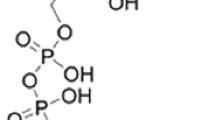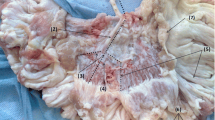Abstract
This study aimed at characterizing the influence of endothelium on noradrenaline release from the canine pulmonary artery. Tritium overflow from intact or endothelium-free vessels preloaded with 0.2 μmol.1−1 3H-noradrenaline was evoked by electrical stimulation (1 Hz, during 5 min) or potassium (25–100 mmol. 1−1).
The fractional release of tritium evoked by electrical stimulation was increased by removing the endothelium [from 1.7 (1.2; 2.4) to 2.7(2.3; 3.2) × 10−5. pulse−1, n = 10; P < 0.05]. Neither NG-nitro-l-arginine methyl ester (l-NAME) (up to 300 μmol.l−1) nor indomethacin (up to 30 μml.l−1), nor endothelin-1 (up to 30 nmol.l−1), nor suramin (up to 300 μmol.l−1) changed tritium release evolved by electrical stimulation. In contrast, the selective A1-adenosine antagonist 1,3-dipropyl-8-cyclopentylxanthine (DPCPX) (3.3-33 nmol.l−1) concentration-dependently increased, and the selective A1-adenosine agonist N6-cyclopentyladenosine (CPA) (3.3–100 nmol. l−1) concentration-dependently decreased the evoked release of noradrenaline. Since the effects of DPCPX were observed in endothelium-intact tissues only, it may be concluded that adenosine secreted by the endothelium activates prejunctional release-inhibiting A1-receptors. Tetraethylammonium (TEA) (3.3–33 mmol. l−1) enhanced tritium overflow evoked by electrical stimulation more in endothelium-free than in endothelium-intact vessels, indicating that some K+-channel opener is involved in the inhibitory role of endothelium on noradrenaline release. Since it had been previously shown that A1-adenosine receptors are coupled to K+-channels, it is suggested that adenosine may inhibit noradrenaline release through the opening of K+-channels.
In conclusion, the results show that in the canine pulmonary artery, adenosine is a good candidate for the endothelium-dependent inhibitory factor which is responsible for the reduction of noradrenaline release evoked by electrical stimulation.
Similar content being viewed by others
References
Böhm M, Brückner R, Neumann J, Schmitz W, Scholz H, Starbatty J (1986) Role of guanine nucleotide-binding protein in the regulation by adenosine of cardiac potassium conductance and force of contraction. Evaluation with pertussis toxin. Naunyn-Schmiedeberg's Arch Pharmacol 332:403–405
Bray KM, Quast U (1991) Differences in the K+ channels opened by cromakalim, acetylcholine and substance P in rat aorta and pig coronary artery. Br J Pharmacol 102:585–594
Brayden JE (1991) Hyperpolarization and relaxation of resistance arteries in response to adenosine diphosphate. Distribution and mechanism of action. Circ Res 69:1415–1420
Burnstock G (1990) Local mechanisms of blood flow control by perivascular nerves and endothelium. J Hypert 8 [Suppl 7]: 95–106
Cavero I, Mondot S, Mestre M (1989) Vasorelaxant effects of cromakalim in rats are mediated by glibenclamide-sensitive potassium channels. J Pharmacol Exp Ther 248:1261–1267
Chen G, Suzuki H, Weston AH (1988) Acetylcholine releases endothelium-derived hyperpolarizing factor and EDRF from rat blood vessels. Br J Pharmacol 95:1165–1174
Cohen RA, Weisbrod RM (1988) Endothelium inhibits norephinephrine release from adrenergic nerves of rabbit carotid artery. Am J Physiol 254:H871-H878
Edwards G, Weston AH (1993) The pharmacology of ATP-sensitive potassium channels. Ann Rev Pharmacol Toxicol 33:597–637
Feletou M, Vanhoutte PM (1988) Endothelium-dependent hyperpolarization of canine coronary smooth muscle. Br J Pharmacol 93:515–524
Greenberg S, Friedrich DPJ, Peevy K, Tanaka TP (1989) The endothelium modulates adrenergic neurotransmission to canine pulmonary arteries and veins. Eur J Pharmacol 162:67–80
Guimarães S, Osswald W (1969) Adrenergic receptors in the veins of the dog. Eur J Pharmacol 5:133–140
Guimarães S, Brandão F, Paiva MQ (1978) A study of the adrenoceptor-mediated feedback mechanisms by using adrenaline as a false transmitter. Naunyn-Schmiedeberg's Arch Pharmacol 305:185–188
Harms HH, Wardeh G, Mulder AH (1978) Adenosine modulates depolarization-induced release of 3H-noradrenaline from slices of rat brain neocortex. Eur J Pharmacol 49:305–308
Henseling M, Graefe K-H, Trendelenburg U (1978) The rate constants for the efflux of the metabolites of noradrenaline from rabbit aortic strips. Naunyn-Schmiedeberg's Arch Pharmacol 302:207–215
Hoyle CHV, Knight GE, Burnstock, G (1990) Suramin antagonises responses to P2-purinoceptor agonist and purinergic nerve stimulation in the guinea-pig urinary bladder and taenia coli. Br J Pharmacol 99:617–621
Luchelli-Fortis MA, Langer SZ (1975) Selective inhibition by hydrocortisone of 3H-normetanephrine formation during 3H-transmitter release elicited by nerve stimulation in the isolated nerve-muscle preparation of the cat nictitating membrane. Naunyn-Schmiedeberg's Arch Pharmacol 287:261–275
McPherson GA, Angus J (1991) Evidence that acetylcholine-mediated hyperpolarization of the rat small mesenteric artery does not involve the K+ channel opened by cromakalim. Br J Pharmacol 103:1184–1190
Mombouli J-V, Vanhoutte PM (1995) Kinins and endothelial control of vascular smooth muscle. Ann Rev Pharmacol Toxicol 35:679–705
Nelson MT, Patlak JB, Worley JF, Standen NB (1990) Calcium channels, potassium channels and voltage-dependence of arterial smooth muscle tone. Am J Physiol 259:C3-C18
Palmer RMJ, Ashton DS, Moncada S (1988) Vascular endothelial cells synthetize nitric oxide from l-arginine. Nature 333:664–667
Sedaa KO, Bjur RA, Shinozuka K, Westfall DP (1990) Nerve and drug-induced release of adenine nucleosides and nucleotides from rabbit aorta. J Pharmacol Exp Ther 252:1060–1067
Shinozuka K, Sedaa KO, Bjur RA, Westfall DP (1991) Participation by purines in the modulation of norepinephrine release by methoxamine. Eur J Pharmacol 192:431–434
Shinozuka K, Kobayashi Y, Shimoura K, Hattori K (1992) Role of nitric oxide from the endothelium on the neurogenic contractile responses of the rabbit pulmonary artery. Eur J Pharmacol 222:113–120
Sturgess NC, Ashford MLJ, Cook DL, Nicholas-Hales C (1985) The sulphonylurea receptor may be an ATP-sensitive potassium channel. Lancet 1:474–475
Suzuk H, Chen G (1990) Endothelium-derived hyperpolarizing factor (EDHF): an endogenous potassium channel activator. News Physicol Sci 5:212–215
Takeuchi K, Shinozuka K, Akimoto H, Ishii R, Hashimoto T (1994) Methoxamine-induced release of endogenous ATP from rabbit pulmonary artery. Eur J Pharmacol 254:287–290
Thorin E, Atkinson J (1994) Modulation by the endothelium of sympathetic vasconstriction in an in vitro preparation of the rat tail artery. Br J Pharmacol 111:351–357
Toda N, Yoshida K, Okamura T (1991) Analysis of the potentiating action of NG-nitro-l-arginine on the contraction of the dog temporal artery elicited by transmural stimulation of noradrenergic nerves,. Naunyn-Schmiedeberg's Arch Pharmacol 343: 221–224
Vane JR (1971) Inhibition of prostaglandins as a mechanism of action for aspirin-like drugs. Nature 231:232–235
von Kügelgen I, Kurz K, Starke K (1993) Axon terminal P2-purinoceptors in feedback control of sympathetic transmitter release. Neuroscience 56:263–267
Wiklund NP, Öhlen A, Cederqvist B (1988) Inhibition of adrenergic neuroeffector transmission by endothelin in the guinea-pig femoral artery. Acta Physiol Scand 134:311–316
Yaganisawa M, Kurihara H, Kimura S, Tomboe Y, Kobayashi M, Mitsuai Y, Yasaki Y, Goto K, Masaki T (1988) A novel vasoconstrictor peptide produced by vascular endothelial cells. Nature 332:411–415
Author information
Authors and Affiliations
Rights and permissions
About this article
Cite this article
Vaz-da-Silva, M., Guimarães, S. & Moura, D. Adenosine and the endothelium-dependent modulation of 3H-noradrenaline release in the canine pulmonary artery. Naunyn-Schmiedeberg's Arch Pharmacol 352, 640–645 (1995). https://doi.org/10.1007/BF00171323
Received:
Accepted:
Issue Date:
DOI: https://doi.org/10.1007/BF00171323




